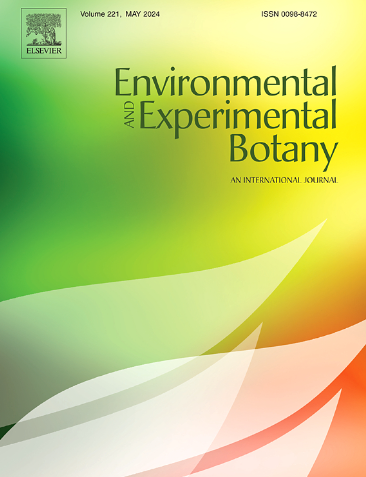在湿地生态系统中,土壤深度,而不是水文梯度,决定了苔草对水和氮的吸收
IF 4.7
2区 生物学
Q2 ENVIRONMENTAL SCIENCES
引用次数: 0
摘要
植物对氮和水分的获取是影响植物生产力的主要因素。植物可以通过改变根的结构来达到足够的吸收水平。然而,资源获取往往仅仅是从根系生物量的分布推断出来的,而不是实际测量出来的。采用2H和15N(以NO3-的形式)稳定同位素标记方法,测量了不同土壤深度对亚热带河岸湿地系统中苔草(Carex thunbergii)在三个地下水位上的水分和氮吸收的贡献。标记20小时后,分别在蒸腾水分和叶片中追踪到同位素2H和15N。同时,测定了不同土壤深度下速效氮和水分的垂直分布规律以及根系的吸收特性。随着地下水位的增加,黄柏根系呈现出海绵状、获取性浅根和致密、保守性深根的二态分布。大多数土壤氮和吸收根(以根长密度[RLD]或吸收根生物量[ARB]测量)都集中在表土中,超过85% %的吸收根出现在10 cm以上深度。我们发现,与氮吸收相比,水分吸收对增加的地下水位、较低的ARB和RLD更为敏感。此外,土壤深度(F = 61.85, p <; 0.001)而不是水文梯度(F = 16.85, p <; 0.001)决定了植物的水分和氮获取模式。当所有土壤深度的数据结合在一起时,水和氮的吸收模式彼此之间具有良好的相关性,并且超过50% %的氮吸收变化可以用水分吸收来解释。随着地下水位的增加,这些模式分别与ARB、RLD和N有效性相关,表明在饱和土壤条件下,土壤因子可能在控制资源利用方面超过功能特征。这些结果表明,黄颡鱼对水分和氮的获取具有不同的深度适应性,不受地下水位的影响。本文章由计算机程序翻译,如有差异,请以英文原文为准。
Soil depth, rather than hydrological gradient, dominates uptake of water and nitrogen by Carex thunbergii in a wetland ecosystem
Plant acquisition of nitrogen (N) and water is a dominant aspect shaping plant productivity. Plants can achieve adequate uptake levels by modifying root architecture. Resource acquisition, however, is often merely inferred from the distribution of root biomass rather than being actually measured. We used 2H and 15N (in the form of NO3-) stable isotope labeling approach to measure the contribution of different soil depths to the water and N uptake of a sedge species Carex thunbergii across three groundwater table levels in a subtropical riparian wetland system, China. Twenty hours after labelling, the isotopes 2H and 15N were traced in the transpiration water and leaves, respectively. Concurrently, we measured the vertical patterns of available N and water, as well as absorptive root traits at different soil depths. With increasing water table level, C. thunbergii exhibited a dimorphic root pattern, one being spongy, acquisitive, shallow roots and the other dense, conservative deep roots. Most soil N and absorptive roots (either measured as root length density [RLD], or absorptive root biomass [ARB]) were both concentrated in the topsoil, with more than 85 % of absorptive roots occurring at upper 10 cm depth. We found that water uptake was more sensitive to increased water table depth, lower ARB, and RLD than was N uptake. Also soil depth (F = 61.85, p < 0.001), rather than the hydrological gradient (F = 16.85, p < 0.001), determined the plant water and N acquisition patterns. Water and N uptake patterns were well correlated with each other when data from all soil depths were combined, and more than 50 % of the variation in uptake of N was explained by water uptake. These patterns were themselves correlated with ARB, RLD, and N availability with increasing water table, respectively, suggesting that edaphic factors might override functional traits in controlling resource use under conditions of saturated soils in this wetland ecosystem. These results indicate that C. thunbergii has distinct depth-specific adaptations in terms of water and N acquisition that were independent from the effects of water table.
求助全文
通过发布文献求助,成功后即可免费获取论文全文。
去求助
来源期刊

Environmental and Experimental Botany
环境科学-环境科学
CiteScore
9.30
自引率
5.30%
发文量
342
审稿时长
26 days
期刊介绍:
Environmental and Experimental Botany (EEB) publishes research papers on the physical, chemical, biological, molecular mechanisms and processes involved in the responses of plants to their environment.
In addition to research papers, the journal includes review articles. Submission is in agreement with the Editors-in-Chief.
The Journal also publishes special issues which are built by invited guest editors and are related to the main themes of EEB.
The areas covered by the Journal include:
(1) Responses of plants to heavy metals and pollutants
(2) Plant/water interactions (salinity, drought, flooding)
(3) Responses of plants to radiations ranging from UV-B to infrared
(4) Plant/atmosphere relations (ozone, CO2 , temperature)
(5) Global change impacts on plant ecophysiology
(6) Biotic interactions involving environmental factors.
 求助内容:
求助内容: 应助结果提醒方式:
应助结果提醒方式:


